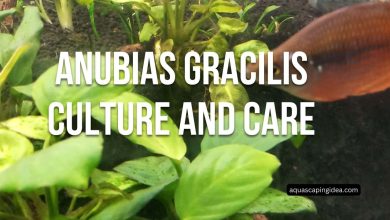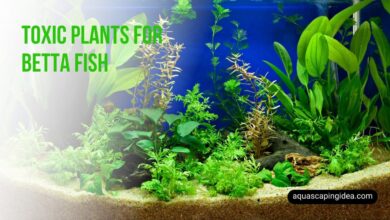How to Trim Aquarium Plants?
Aquarium plants are more than just decorative elements; they’re living, growing organisms that play a crucial role in the health and beauty of your underwater ecosystem. Like a well-tended garden, an aquarium requires regular maintenance to thrive. One of the most important aspects of this maintenance is the proper trimming of aquatic plants. This practice not only keeps your aquarium looking its best but also promotes the health and growth of your aquatic flora.
In this comprehensive guide, we’ll dive deep into the world of aquarium plant trimming. Whether you’re a seasoned aquarist or just starting your journey into the fascinating realm of planted tanks, this article will equip you with the knowledge and techniques you need to keep your underwater garden in pristine condition.
Understanding Aquarium Plants
Before we delve into the intricacies of trimming, it’s essential to understand the nature of aquarium plants and why regular maintenance is crucial.
Types of Aquarium Plants
Aquarium plants can be broadly categorized into three groups:
- Foreground Plants: These low-growing species carpet the bottom of your tank, creating a lush, green base for your aquascape. Examples include Dwarf Baby Tears (Hemianthus callitrichoides) and Glossostigma (Glossostigma elatinoides).
- Midground Plants: These medium-height plants add depth and texture to your aquarium. Species like Anubias and Java Fern are popular choices.
- Background Plants: Tall-growing species that create a backdrop for your aquascape. Vallisneria and Amazon Sword plants are common examples.
Each of these plant types requires different trimming techniques, which we’ll explore in detail later in this guide.
The Importance of Regular Trimming
Regular trimming is crucial for several reasons:
- Aesthetic Appeal: Trimming maintains the shape and size of plants, preserving the intended design of your aquascape.
- Plant Health: Pruning stimulates new growth and prevents overcrowding, which can lead to nutrient deficiencies.
- Water Quality: Removing dead or decaying plant matter helps maintain water quality by reducing the organic waste in your tank.
- Light Distribution: Proper trimming ensures that light can reach all areas of your tank, promoting healthy growth for all plants.
- Fish Health: Well-maintained plants provide better habitat and hiding spots for fish, reducing stress and promoting overall health.
Essential Tools for Aquarium Plant Trimming
Before we start trimming, let’s ensure you have the right tools for the job. Having the proper equipment not only makes the task easier but also helps prevent damage to your plants and aquarium.
1. Aquarium Plant Scissors
Invest in a high-quality pair of aquarium scissors. These are specially designed with long, narrow blades that allow for precise cuts in hard-to-reach areas of your tank. Look for stainless steel scissors to prevent rust.
2. Curved Scissors
Curved scissors are excellent for trimming plants with rounded shapes or for reaching around hardscape elements in your tank.
3. Wave Scissors
These uniquely shaped scissors are perfect for creating even, wave-like cuts across carpeting plants.
4. Tweezers
Long tweezers are essential for planting and replanting trimmed stems. They also help in removing cut plant matter from the tank.
5. Algae Scraper
While not directly used for trimming, an algae scraper is useful for cleaning the glass before and after trimming to ensure good visibility.
6. Bucket or Container
You’ll need a container to collect trimmed plant matter. This prevents debris from floating around your tank and potentially clogging your filter.
7. Net
A fine-mesh net is useful for scooping up small plant clippings that may escape during trimming.
8. Gloves
While not essential, aquarium-safe gloves can protect your hands and prevent the introduction of harmful substances into your tank.
Preparation for Trimming
Proper preparation is key to a successful trimming session. Follow these steps before you begin:
- Plan Your Design: Before you start trimming, have a clear vision of how you want your aquascape to look. This will guide your trimming decisions.
- Clean Your Tools: Ensure all your tools are clean and sterilized to prevent the introduction of harmful bacteria or algae into your tank.
- Turn Off Equipment: Switch off filters, CO2 systems, and other equipment to prevent plant cuttings from being sucked into the machinery.
- Perform a Water Change: A partial water change before trimming can help improve water clarity and remove any floating debris.
- Check Water Parameters: Ensure your water parameters are stable, as trimming can sometimes cause minor fluctuations in water chemistry.
Techniques for Trimming Different Types of Aquarium Plants
Now that we’re prepared, let’s explore the specific techniques for trimming various types of aquarium plants.
Trimming Stem Plants
Stem plants are among the most common in aquariums and often require the most frequent trimming. These include species like Rotala, Ludwigia, and Bacopa.
- Identify the Growth Pattern: Observe how your stem plants grow. Most send out side shoots as they grow taller.
- Choose Your Cutting Point: For bushy growth, cut the stem about 1/3 from the top. This encourages branching and creates a fuller appearance.
- Make Clean Cuts: Use sharp scissors to make clean, angled cuts just above a leaf node. This promotes faster healing and new growth.
- Remove Lower Leaves: For the portion you’re replanting, remove the lower leaves to encourage root growth.
- Replant or Discard: You can replant the trimmed tops to propagate new plants or discard them if your tank is already full.
Trimming Carpeting Plants
Carpeting plants like Dwarf Baby Tears (HC Cuba) or Monte Carlo require regular trimming to maintain a lush, low-growing appearance.
- Use Wave Scissors: Wave scissors help create an even, natural-looking cut across your carpet.
- Trim in Sections: Divide your carpet into sections and trim one area at a time to ensure evenness.
- Cut at an Angle: Trim at a slight angle to create depth and prevent a flat, artificial look.
- Vacuum Trimmings: Use a siphon or net to remove trimmed leaves immediately to prevent them from floating and settling elsewhere.
Trimming Rosette Plants
Rosette plants like Amazon Swords or Cryptocorynes grow from a central crown and require a different approach.
- Remove Old Leaves: Start by trimming off any old, damaged, or yellowing leaves at the base.
- Trim for Shape: If the plant is too large, you can trim larger, outer leaves to maintain size and shape.
- Avoid Cutting the Crown: Never cut the central crown of a rosette plant, as this is where new growth emerges.
Trimming Rhizome Plants
Plants like Anubias and Java Fern grow from a rhizome and require minimal trimming.
- Remove Dead Leaves: Trim off any dead or yellowing leaves at the base where they connect to the rhizome.
- Trim the Rhizome: If the plant is too large, you can cut the rhizome into sections, ensuring each piece has some leaves and roots.
- Propagate: Trimmed rhizome sections can be attached to hardscape or left floating to grow new plants.
Post-Trimming Care
After trimming, your aquarium plants need some special attention to recover and thrive:
- Water Change: Perform a partial water change to remove any remaining plant debris and reset water parameters.
- Adjust Fertilization: Trimmed plants may need fewer nutrients initially. Monitor your plants and adjust fertilization as necessary.
- Maintain CO2 Levels: If you use CO2, ensure levels remain stable to support new growth.
- Monitor Light: Newly trimmed plants may be more susceptible to algae growth. Monitor light levels and duration, adjusting if necessary.
- Regular Observation: Keep a close eye on your plants in the days following trimming. Look for signs of stress or new growth and adjust care as needed.
Common Mistakes to Avoid
Even experienced aquarists can make mistakes when trimming. Here are some common pitfalls to avoid:
- Over-trimming: Removing too much plant mass at once can shock your plants and upset the tank’s balance.
- Using Dull Tools: Dull scissors can crush plant stems instead of making clean cuts, leading to damaged plants.
- Ignoring Fish: Be mindful of your fish while trimming. Sudden changes in their environment can cause stress.
- Neglecting Clean-up: Failing to remove all trimmed plant matter can lead to ammonia spikes and algae blooms.
- Inconsistent Maintenance: Sporadic, heavy trimming is more stressful for plants than regular, light pruning.
Seasonal Considerations
The changing seasons can affect your aquarium plants, even indoors. Here’s how to adjust your trimming routine throughout the year:
Spring and Summer
During these growth-heavy seasons:
- Increase trimming frequency to manage rapid growth.
- Monitor nutrient levels closely, as faster growth means higher nutrient uptake.
- Be vigilant about algae growth, which can proliferate in warmer temperatures.
Fall and Winter
As growth slows:
- Reduce trimming frequency to avoid stressing plants.
- Adjust lighting duration to mimic natural seasonal changes.
- Consider reducing fertilization to match slower growth rates.
Advanced Trimming Techniques
For those looking to take their aquascaping skills to the next level, here are some advanced techniques:
1. Topiary-Style Trimming
Create shaped bushes or spheres from stem plants by regularly trimming to maintain a specific form.
2. Terracing
Use careful trimming to create a stepped or terraced effect with your carpeting plants.
3. Selective Pruning
Enhance the natural growth pattern of your plants by selectively removing specific stems or leaves to create a more naturalistic appearance.
4. Trimming for Color
Some plants, like Rotala species, can display different colors depending on how they’re trimmed. Experiment with trimming heights to achieve desired coloration.
FAQs
Q: How often should I trim my aquarium plants?
A: The frequency depends on the species and growth rate. Fast-growing stem plants may need weekly trimming, while slow-growing species like Anubias might only need trimming every few months.
Q: Can I trim my plants too much?
A: Yes, over-trimming can stress plants and upset your tank’s balance. As a general rule, avoid removing more than 1/3 of a plant’s mass at once.
Q: Should I remove my fish before trimming?
A: It’s not necessary to remove fish, but be mindful of their presence and try not to disturb them excessively during trimming.
Q: What should I do with the trimmed plant matter?
A: You can replant healthy cuttings to propagate new plants, share them with other aquarists, or compost them. Never release aquarium plants into natural waterways.
Q: My plants aren’t growing well after trimming. What’s wrong?
A: This could be due to over-trimming, poor nutrition, or inadequate lighting. Check your water parameters and ensure your plants are receiving proper care.
Conclusion
Mastering the art of trimming aquarium plants is a journey that combines science, aesthetics, and patience. Regular, thoughtful pruning not only maintains the beauty of your underwater landscape but also promotes the health and vitality of your aquatic ecosystem. As you gain experience, you’ll develop an intuitive understanding of your plants’ needs and growth patterns, allowing you to create and maintain truly stunning aquascapes.
Remember, every aquarium is unique, and what works for one setup may not be ideal for another. Don’t be afraid to experiment, observe, and adjust your techniques as you learn. With time and practice, you’ll develop the skills to keep your aquatic garden thriving and beautiful year-round.



